HALOBETASOL PROPIONATE aerosol, foam
Halobetasol propionate by
Drug Labeling and Warnings
Halobetasol propionate by is a Prescription medication manufactured, distributed, or labeled by Mayne Pharma, Pharmasol Corporation. Drug facts, warnings, and ingredients follow.
Drug Details [pdf]
-
HIGHLIGHTS OF PRESCRIBING INFORMATION
These highlights do not include all the information needed to use HALOBETASOL PROPIONATE topical foam safely and effectively.
See full prescribing information for HALOBETASOL PROPIONATE topical foam.
HALOBETASOL PROPIONATE topical foam
Initial U.S. Approval: 1990INDICATIONS AND USAGE
Halobetasol Propionate Topical Foam is a corticosteroid indicated for the topical treatment of plaque psoriasis in patients eighteen (18) years of age and older. (1)
DOSAGE AND ADMINISTRATION
- Shake before use. (2)
- Apply Halobetasol Propionate Topical Foam as a thin uniform film to the affected skin twice daily for up to two weeks. Rub in gently. (2)
- Do not use more than 50 grams per week. (2)
- Discontinue Halobetasol Propionate Topical Foam when control is achieved. (2)
- If no improvement is seen within 2 weeks, reassess diagnosis. (2)
- Treatment beyond 2 consecutive weeks is not recommended. (2)
- Do not use with occlusive dressings unless directed by a physician. (2)
- Avoid use on the face, groin, or axillae. (2)
- Halobetasol Propionate Topical Foam is not for ophthalmic, oral, or intravaginal use. (2)
DOSAGE FORMS AND STRENGTHS
Topical foam: 0.05% (0.5 mg/g). (3)
CONTRAINDICATIONS
None. (4)
WARNINGS AND PRECAUTIONS
- Reversible hypothalamic-pituitary-adrenal (HPA) axis suppression may occur, with the potential for glucocorticosteroid insufficiency during or after treatment. (5.1)
- Systemic effects following prolonged exposure of topical corticosteroids may also include Cushing's syndrome, hyperglycemia, and glucosuria. (5.1)
- Use of potent corticosteroids on large areas, for prolonged durations, under occlusive dressings, or on an altered skin barrier may increase systemic exposure. (5.1)
- Children may be more susceptible to systemic toxicity when treated with topical corticosteroids. (5.1, 8.4)
- Local adverse reactions with topical steroids may include atrophy, striae, irritation, acneiform eruptions, hypopigmentation, and allergic contact dermatitis. Adverse reactions may be more likely to occur with occlusive use or more potent corticosteroids. (5.2)
- Topical corticosteroids may increase the risk of cataract and glaucoma formation. If visual symptoms occur, consider referral to an ophthalmologist for evaluation. (5.3)
- Initiate appropriate therapy if concomitant skin infections develop. (5.4)
- Flammable contents. Avoid heat, flame, or smoking during and immediately following application. (5.6)
ADVERSE REACTIONS
The most commonly reported adverse reactions (≥1%) are application site pain and headache. (6.1)
To report SUSPECTED ADVERSE REACTIONS, contact Mayne Pharma at 1-844-825-8500 or contact FDA at 1-800-FDA-1088 or www.fda.gov/medwatch.
See 17 for PATIENT COUNSELING INFORMATION and FDA-approved patient labeling.
Revised: 6/2019
-
Table of Contents
FULL PRESCRIBING INFORMATION: CONTENTS*
1 INDICATIONS AND USAGE
2 DOSAGE AND ADMINISTRATION
3 DOSAGE FORMS AND STRENGTHS
4 CONTRAINDICATIONS
5 WARNINGS AND PRECAUTIONS
5.1 Hypothalamic-Pituitary-Adrenal (HPA) Axis Suppression and Other Adverse Endocrine Effects
5.2 Local Adverse Reactions
5.3 Ophthalmic Adverse Reactions
5.4 Concomitant Skin Infections
5.5 Allergic Contact Dermatitis
5.6 Flammability
6 ADVERSE REACTIONS
6.1 Clinical Trials Experience
8 USE IN SPECIFIC POPULATIONS
8.1 Pregnancy
8.2 Lactation
8.4 Pediatric Use
8.5 Geriatric Use
10 OVERDOSAGE
11 DESCRIPTION
12 CLINICAL PHARMACOLOGY
12.1 Mechanism of Action
12.2 Pharmacodynamics
12.3 Pharmacokinetics
13 NONCLINICAL TOXICOLOGY
13.1 Carcinogenesis, Mutagenesis, Impairment of Fertility
14 CLINICAL STUDIES
16 HOW SUPPLIED/STORAGE AND HANDLING
16.1 How Supplied
16.2 Storage
16.3 Handling
17 PATIENT COUNSELING INFORMATION
- * Sections or subsections omitted from the full prescribing information are not listed.
- 1 INDICATIONS AND USAGE
-
2 DOSAGE AND ADMINISTRATION
Shake can prior to use. Apply Halobetasol Propionate Topical Foam as a thin uniform film to the affected skin twice daily for up to two weeks. Rub in gently. Wash hands after applying the product.
Discontinue therapy when control is achieved. If no improvement is seen within two weeks, reassessment of the diagnosis may be necessary.
Treatment beyond two weeks is not recommended and the total dosage should not exceed 50 grams per week because of the potential for the drug to suppress the hypothalamic-pituitary adrenal (HPA) axis [see Warnings and Precautions (5.1)]. Do not use with occlusive dressings unless directed by a physician.
Avoid use on the face, groin, or axillae.
Avoid contact with eyes. Wash hands after each application, unless it is for treatment of the hands.
Halobetasol Propionate Topical Foam is for topical use only.
Halobetasol Propionate Topical Foam is not for ophthalmic, oral, or intravaginal use.
- 3 DOSAGE FORMS AND STRENGTHS
- 4 CONTRAINDICATIONS
-
5 WARNINGS AND PRECAUTIONS
5.1 Hypothalamic-Pituitary-Adrenal (HPA) Axis Suppression and Other Adverse Endocrine Effects
Halobetasol Propionate Topical Foam is a topical corticosteroid that has been shown to suppress the hypothalamic-pituitary-adrenal (HPA) axis.
Systemic effects of topical corticosteroids may include reversible HPA axis suppression, with the potential for glucocorticosteroid insufficiency. This may occur during treatment or upon withdrawal of treatment of the topical corticosteroid. The potential for hypothalamic-pituitary adrenal (HPA) suppression with Halobetasol Propionate Topical Foam was evaluated in a study of 25 adult subjects with moderate to severe plaque psoriasis involving ≥15% of their body surface area. Halobetasol Propionate Topical Foam produced laboratory evidence of HPA axis suppression when used twice daily for two weeks in 6 out of 25 (24%) adult subjects with plaque psoriasis. Recovery of HPA axis function was generally prompt with the discontinuation of treatment [see Clinical Pharmacology (12.2)].
Because of the potential for systemic absorption, use of topical corticosteroids, including Halobetasol Propionate Topical Foam, may require that patients be evaluated periodically for evidence of HPA axis suppression. Factors that predispose a patient using a topical corticosteroid to HPA axis suppression include the use of more potent corticosteroids, use over large surface areas, prolonged use, occlusive use, use on an altered skin barrier, concomitant use of multiple corticosteroid-containing products, liver failure, and young age. An ACTH stimulation test may be helpful in evaluating patients for HPA axis suppression.
If HPA axis suppression is documented, attempt to gradually withdraw the drug, reduce the frequency of application, or substitute a less potent steroid. Manifestations of adrenal insufficiency may require supplemental systemic corticosteroids. Recovery of HPA axis function is generally prompt and complete upon discontinuation of topical corticosteroids.
Systemic effects of topical corticosteroids may also include Cushing's syndrome, hyperglycemia, and glucosuria. Use of more than one corticosteroid-containing product at the same time may increase the total systemic exposure to topical corticosteroids.
Pediatric patients may be more susceptible than adults to systemic toxicity from the use of topical corticosteroids due to their larger surface-to-body mass ratios [see Use in Specific Populations (8.4)].
5.2 Local Adverse Reactions
Local adverse reactions from topical corticosteroids may include atrophy, striae, telangiectasias, burning, itching, irritation, dryness, folliculitis, acneiform eruptions, hypopigmentation, perioral dermatitis, allergic contact dermatitis, secondary infection, and miliaria. These may be more likely to occur with occlusive use, prolonged use, or use of higher potency corticosteroids, including Halobetasol Propionate Topical Foam. Some local adverse reactions may be irreversible.
5.3 Ophthalmic Adverse Reactions
Use of topical corticosteroids may increase the risk of posterior subcapsular cataracts and glaucoma. Cataracts and glaucoma have been reported in postmarketing experience with the use of topical corticosteroid products.
5.4 Concomitant Skin Infections
Use an appropriate antimicrobial agent if a skin infection is present or develops. If a favorable response does not occur promptly, discontinue use of Halobetasol Propionate Topical Foam until the infection has been adequately treated.
5.5 Allergic Contact Dermatitis
Allergic contact dermatitis with corticosteroids is usually diagnosed by observing failure to heal rather than noting a clinical exacerbation. Consider confirmation of a clinical diagnosis of allergic contact dermatitis by appropriate patch testing. Discontinue Halobetasol Propionate Topical Foam if allergic contact dermatitis is established.
-
6 ADVERSE REACTIONS
The following adverse reactions are discussed in greater detail in other sections of the label:
- Hypothalamic-Pituitary-Adrenal (HPA) Axis Suppression and Other Adverse Endocrine Effects [see Warnings and Precautions (5.1)]
- Allergic Contact Dermatitis [see Warnings and Precautions (5.5)]
6.1 Clinical Trials Experience
Because clinical trials are conducted under widely varying conditions, adverse reaction rates observed in the clinical trials of a drug cannot be directly compared to rates in the clinical trials of another drug and may not reflect the rates observed in practice.
In randomized, multicenter, vehicle-controlled clinical trials, 351 adults with plaque psoriasis were treated with Halobetasol Propionate Topical Foam twice daily for up to two weeks (up to approximately 50 grams per week). Table 1 presents selected adverse reactions that occurred in at least 1% of subjects.
Table 1: Adverse Reactions Occurring in ≥ 1% of Subjects through Week 2 HBP Foam
N=351Vehicle Foam
N=353Adverse Reaction % % Skin atrophy (n=1) and telangiectasia (n=2) were reported with Halobetasol Propionate Topical Foam, but not with vehicle foam. Application site burning/stinging 12% 15% Application site pain 1% <1% Headache 1% <1% -
8 USE IN SPECIFIC POPULATIONS
8.1 Pregnancy
Risk Summary
There are no available data on Halobetasol Propionate Topical Foam use in pregnant women to inform a drug-associated risk for adverse developmental outcomes. In animal reproduction studies, increased malformations, including cleft palate and omphalocele, were observed after oral administration of halobetasol propionate during organogenesis to pregnant rats and rabbits. No comparisons of animal exposure with human exposure may be calculated due to minimal systemic exposure in humans after topical administration of Halobetasol Propionate Topical Foam [see Clinical Pharmacology (12.3)].
The background risk of major birth defects and miscarriage for the indicated population are unknown. In the U.S. general population, the estimated background risk of major birth defects and miscarriage in clinically recognized pregnancies is 2-4% and 15-20%, respectively.
Data
Animal Data
Halobetasol propionate has been shown to cause malformations in rats and rabbits when given orally during organogenesis at doses of 0.04 to 0.1 mg/kg/day in rats and 0.01 mg/kg/day in rabbits. Halobetasol propionate was embryotoxic in rabbits, but not in rats. Cleft palate was observed in both rats and rabbits. Omphalocele was seen in rats, but not in rabbits.
8.2 Lactation
Risk Summary
There are no data on the presence of halobetasol propionate or its metabolites in human milk, the effects on the breastfed infant, or the effects on milk production after topical application to women who are breastfeeding.
Systemically administered corticosteroids appear in human milk and could suppress growth, interfere with endogenous corticosteroid production, or cause other untoward effects. It is not known whether topical administration of corticosteroids could result in sufficient systemic absorption to produce detectable quantities in human milk. The developmental and health benefits of breastfeeding should be considered along with the mother's clinical need for Halobetasol Propionate Topical Foam and any potential adverse effects on the breastfed infant from Halobetasol Propionate Topical Foam or from the underlying maternal condition.
8.4 Pediatric Use
Safety and effectiveness of Halobetasol Propionate Topical Foam in patients younger than 18 years of age have not been established.
Because of higher skin surface area to body mass ratios, pediatric patients are at a greater risk than adults of HPA axis suppression and Cushing's syndrome when they are treated with topical corticosteroids. They are therefore also at greater risk of adrenal insufficiency during or after withdrawal of treatment. Adverse reactions including striae have been reported with use of topical corticosteroids in infants and children [see Warnings and Precautions (5.1)].
HPA axis suppression, Cushing's syndrome, linear growth retardation, delayed weight gain, and intracranial hypertension have been reported in children receiving topical corticosteroids. Manifestations of adrenal suppression in children include low plasma cortisol levels and an absence of response to ACTH stimulation. Manifestations of intracranial hypertension include bulging fontanelles, headaches, and bilateral papilledema [see Warnings and Precautions (5.1)].
-
10 OVERDOSAGE
Topically applied Halobetasol Propionate Topical Foam can be absorbed in sufficient amounts to produce systemic effects [see Warnings and Precautions (5.1)].
-
11 DESCRIPTION
Halobetasol Propionate Topical Foam is a hydroethanolic aerosol foam that contains a corticosteroid, halobetasol propionate. The chemical name of halobetasol propionate is 21 chloro-6α, 9-difluoro-11β, 17-dihydroxy-16β-methylpregna-1, 4-diene-3,20-dione 17 propionate. Halobetasol propionate is a white to off-white crystalline powder with a molecular weight of 484.96 and a molecular formula of C25H31ClF2O5. It has the following structural formula:
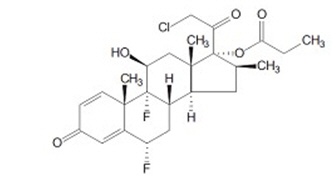
It is practically insoluble in water and freely soluble in dichloromethane and in acetone. Each gram of Halobetasol Propionate Topical Foam contains 0.5 mg of halobetasol propionate in a white to off-white foam base consisting of alcohol (specially denatured alcohol [SDA]), benzoic acid, cetostearyl alcohol, emulsifying wax, polyoxyl 20 cetostearyl ether, propylene glycol and purified water. Halobetasol Propionate Topical Foam is dispensed from an aluminum can pressurized with a hydrocarbon (isobutane and propane) propellant.
-
12 CLINICAL PHARMACOLOGY
12.1 Mechanism of Action
Corticosteroids play a role in cellular signaling, immune function, inflammation, and protein regulation; however, the precise mechanism of action in plaque psoriasis is unknown.
12.2 Pharmacodynamics
The potential for hypothalamic-pituitary adrenal (HPA) suppression was evaluated in a study of 25 adult subjects with moderate to severe plaque psoriasis involving a mean body surface area of 18.4%. A mean dose of 3.7 g Halobetasol Propionate Topical Foam was applied twice daily for two weeks and produced laboratory evidence of HPA axis suppression in 6 of 25 (24%) subjects. In this study, the criteria for HPA-axis suppression was a serum cortisol level of less than or equal to 18 micrograms per deciliter 30 minutes after stimulation with cosyntropin (adrenocorticotropic hormone). These effects were reversible as recovery of HPA axis function was generally prompt with the discontinuation of treatment [see Warnings and Precautions (5.1)].
12.3 Pharmacokinetics
The extent of percutaneous absorption of topical corticosteroids is determined by many factors, including the vehicle, the integrity of the epidermal barrier, and the use of occlusive dressings. Topical corticosteroids can be absorbed from normal intact skin. Inflammation and/or other disease processes in the skin may increase percutaneous absorption.
In the HPA-axis and pharmacokinetic study, as described above in Clinical Pharmacology (12.2), pharmacokinetics was evaluated in a subgroup of 23 adult subjects with moderate to severe plaque psoriasis following twice daily treatment for 14 days with a mean daily dose of 7.4 g. Plasma concentration of halobetasol propionate was measureable in all subjects and steady state was achieved by Day 14. The mean (± standard deviation) Cmax concentration for Halobetasol Propionate Topical Foam on Day 14 was 199.7 ± 217.3 pg/mL, with the corresponding median Tmax value of 1 hour (range 0 – 12 hours); mean area under the halobetasol propionate concentration versus time curve over the dosing interval (AUCt) was 1434.9 ± 1310.6 pg∙h/mL.
-
13 NONCLINICAL TOXICOLOGY
13.1 Carcinogenesis, Mutagenesis, Impairment of Fertility
Long-term animal studies have not been performed to evaluate the carcinogenic potential of halobetasol propionate.
In a 90-day repeat-dose toxicity study in rats, topical administration of Halobetasol Propionate Topical Foam at dose concentrations from 0.005% to 0.05% or from 0.011 to 0.11 mg/kg/day of halobetasol propionate resulted in a toxicity profile consistent with long-term exposure to corticosteroids including adrenal atrophy, histopathological changes in several organ systems indicative of severe immune suppression, and opportunistic fungal and bacterial infections. A noobservable adverse effect level could not be determined in this study. Although the clinical relevance of the findings in animals to humans is not clear, sustained glucocorticoid-related immune suppression may increase the risk of infection and possibly the risk of carcinogenesis.
Halobetasol propionate was not found to be genotoxic in the Ames/Salmonella assay, in the Chinese hamster CHO/HGPRT assay, in the mouse micronucleus test, in the sister chromatid exchange test in somatic cells of the Chinese hamster, or in the chromosome aberration test in somatic cells of Chinese hamsters. Positive mutagenicity effects were observed in two genotoxicity assays: Chinese hamster nuclear anomaly test and mouse lymphoma gene mutation assay in vitro.
Studies in the rat following oral administration at dose levels up to 0.05 mg/kg/day indicated no impairment of fertility or general reproductive performance.
-
14 CLINICAL STUDIES
Halobetasol Propionate Topical Foam was evaluated for the treatment of moderate to severe plaque psoriasis in two multicenter, randomized, double-blind, vehicle-controlled studies (Study 1 [NCT02368210] and Study 2 [NCT02742441]).
These studies were conducted in 560 subjects 18 years of age and older with plaque psoriasis involving between 2% and 12% body surface area. Baseline disease severity was determined using a static, five-level Investigator's Global Assessment (IGA) scale, on which a subject scored either moderate or severe. Overall, approximately 60% of subjects were male and approximately 90% were Caucasian.
Subjects applied Halobetasol Propionate Topical Foam or vehicle to all affected areas twice daily for up to 14 consecutive days.
The primary measure of efficacy was Overall Treatment Success, defined as the proportion of subjects who were cleared or almost cleared with at least a two-grade improvement from baseline at Week 2 (end of treatment) based on the IGA. The studies also evaluated treatment success for the individual signs of psoriasis (plaque elevation, scaling, and erythema) at the end of treatment. Table 2 presents these results.
Table 2: Efficacy Results at Week 2 in Subjects with Plaque Psoriasis Study 1 Study 2 HBP Foam
N=75Vehicle Foam
N=76HBP Foam
N=205Vehicle Foam
N=204- * Subjects whose condition was cleared or almost cleared of all signs of psoriasis and with at least a two-grade improvement from baseline based on the IGA.
- † Subjects who were cleared or almost cleared of the designated clinical sign with at least a two-grade improvement from baseline. Individual signs were rated by severity using a five-point scale ranging from 0 (clear) to 4 (severe). Subjects with baseline value of 0 or 1 were excluded.
Overall Treatment Success* 19 (25%) 3 (4%) 63 (31%) 15 (7%) Plaque Elevation† 20/75 (27%) 3/76 (4%) 71/202 (35%) 20/203 (10%) Scaling† 21/75 (28%) 4/76 (5%) 68/201 (34%) 20/204 (10%) Erythema† 16/75 (21%) 2/76 (3%) 59/205 (29%) 17/204 (8%) -
16 HOW SUPPLIED/STORAGE AND HANDLING
16.1 How Supplied
Halobetasol Propionate Topical Foam, 0.05% is a white to off-white foam. It is supplied in aluminum cans of:
50 grams (NDC: 51862-606-50)
100 grams (2 cans of 50 grams) (NDC: 51862-606-02)
-
17 PATIENT COUNSELING INFORMATION
Advise the patient to read the FDA-approved patient labeling (Patient Information and Instructions for Use).
This information is intended to aid in the safe and effective use of this medication. It is not a disclosure of all administration instructions or all possible adverse or unintended effects.
Inform patients of the following:
Important Administration Instructions:
- Total dosage should not exceed 50 grams (one can) per week [see Dosage and Administration (2)].
- Advise patients to avoid use on the face, groin, or axillae. Avoid contact with eyes [see Dosage and Administration (2)].
- Inform patients that topical corticosteroids may cause HPA axis suppression and local adverse reactions [see Warnings and Precautions (5.1)].
- Breastfeeding women should not apply Halobetasol Propionate Topical Foam directly to the nipple and/or areola to avoid direct exposure to the infant [see Use in Specific Populations (8.2)].
- This product is flammable; avoid heat, flame, or smoking during and immediately following application of this product.
- SPL UNCLASSIFIED SECTION
-
PATIENT PACKAGE INSERT
PATIENT INFORMATION
HALOBETASOL PROPIONATE (hal-oh-BAY-ta-sol PRO-pee-oh-nate)
Topical Foam, 0.05%This Patient Information has been approved by the U.S. Food and Drug Administration. Issued: 01/2019 Important: Halobetasol Propionate Topical Foam is for use on the skin only. Do not apply Halobetasol Propionate Topical Foam near or in your eyes, mouth, or vagina. What is Halobetasol Propionate Topical Foam?
Halobetasol Propionate Topical Foam is a prescription corticosteroid medicine used on the skin to treat plaque psoriasis in people 18 years of age and older.
It is not known if Halobetasol Propionate Topical Foam is safe and effective in children under 18 years of age.Before using Halobetasol Propionate Topical Foam, tell your healthcare provider about all of your medical conditions, including if you: - have had irritation or other skin reaction to a steroid medicine in the past.
- have a skin infection. You may need medicine to treat the skin infection before using Halobetasol Propionate Topical Foam.
- have diabetes.
- have adrenal gland problems.
- have liver problems.
- plan to have surgery.
- are pregnant or plan to become pregnant. It is not known if Halobetasol Propionate Topical Foam will harm your unborn baby.
- are breastfeeding or plan to breastfeed. It is not known if Halobetasol Propionate Topical Foam passes into your breast milk. If you use Halobetasol Propionate Topical Foam and breastfeed, do not apply Halobetasol Propionate Topical Foam to your nipple or areola to avoid getting Halobetasol Propionate Topical Foam into your baby's mouth.
Tell your healthcare provider about all the medicines you take, including prescription and over-the counter medicines, vitamins, and herbal supplements. Especially tell your healthcare provider if you take other corticosteroid medicines by mouth, or injection, or use other products on your skin that contain corticosteroid. How should I use Halobetasol Propionate Topical Foam? See the "Instructions for Use" for detailed information about the right way to apply Halobetasol Propionate Topical Foam. - Use Halobetasol Propionate Topical Foam exactly as your healthcare provider tells you to use it.
- Apply a thin layer of Halobetasol Propionate Topical Foam to the affected skin areas 2 times each day.
- You should not use more than 50 grams of Halobetasol Propionate Topical Foam in 1 week.
- Avoid using Halobetasol Propionate Topical Foam on your face, underarms (armpits), or groin areas.
- Do not bandage, cover, or wrap the treated skin area unless your healthcare provider tells you to.
- Talk to your healthcare provider if your skin does not improve after 2 weeks of treatment with Halobetasol Propionate Topical Foam.
- Do not use Halobetasol Propionate Topical Foam longer than 2 continuous weeks unless advised to do so by your prescriber.
- Wash your hands after using Halobetasol Propionate Topical Foam unless you are using the medicine to treat your hands.
What should I avoid while using Halobetasol Propionate Topical Foam? Halobetasol Propionate Topical Foam is flammable. Avoid heat, flame, or smoking during and right after applying Halobetasol Propionate Topical Foam to your skin. What are the possible side effects of Halobetasol Propionate Topical Foam? Halobetasol Propionate Topical Foam may cause serious side effects, including: - Halobetasol Propionate Topical Foam can pass through your skin. Too much Halobetasol Propionate Topical Foam passing through your skin can cause adrenal glands to stop working.
- Cushing's syndrome, a condition that happens when your body is exposed to too much of the hormone cortisol.
- High blood sugar (hyperglycemia).
- Vision problems. Halobetasol Propionate Topical Foam may increase your chance of developing cataract(s) and glaucoma. Tell your healthcare provider if you develop blurred vision or other vision problems during treatment with Halobetasol Propionate Topical Foam.
- Skin reactions at the treated skin site. Tell your healthcare provider if you get any skin reactions or skin infections.
- Effects on growth and weight in children.
Your healthcare provider may do certain blood tests to check for side effects. The most common side effect of Halobetasol Propionate Topical Foam is mild to moderate pain at the treated site. These are not all of the possible side effects of Halobetasol Propionate Topical Foam. Call your doctor for medical advice about side effects. You may report side effects to FDA at 1-800-FDA 1088. How should I store Halobetasol Propionate Topical Foam? - Store Halobetasol Propionate Topical Foam at room temperature between 68°F to 77°F (20°C to 25°C).
- Do not puncture or burn Halobetasol Propionate Topical Foam can.
- Do not store Halobetasol Propionate Topical Foam next to heat or store at temperatures above 120°F (49°C).
- Do not freeze Halobetasol Propionate Topical Foam.
Keep Halobetasol Propionate Topical Foam and all medicines out of the reach of children. General information about the safe and effective use of Halobetasol Propionate Topical Foam. Medicines are sometimes prescribed for purposes other than those listed in a Patient Information leaflet. Do not use Halobetasol Propionate Topical Foam for a condition for which it was not prescribed. Do notgive Halobetasol Propionate Topical Foam to other people, even if they have the same symptoms that you have. It may harm them. You can ask your pharmacist or healthcare provider for information about Halobetasol Propionate Topical Foam that is written for health professionals. What are the ingredients in Halobetasol Propionate Topical Foam? Active ingredient: halobetasol propionate Inactive ingredients: alcohol (specially denatured alcohol [SDA]), benzoic acid, cetostearyl alcohol, emulsifying wax, polyoxyl 20 cetostearyl ether, propylene glycol, and purified water. Halobetasol Propionate Topical Foam is dispensed from an aluminum can pressurized with a hydrocarbon propellant containing isobutane and propane. Distributed by: Mayne Pharma
Greenville, NC 27834
U.S. Patent Pending
For more information call: 1-844-825-8500 -
INSTRUCTIONS FOR USEHALOBETASOL PROPIONATE (hal-oh-BAY-ta-sol PRO-pee-oh-nate) Topical Foam, 0.05%
Read the Patient Information and Instructions for Use before you use Halobetasol Propionate Topical Foam.
Important infomation: Halobetasol Propionate Topical Foam is for skin use only. Do not get Halobetasol Propionate Topical Foam in your mouth, eyes, or vagina.
Parts of the Halobetasol Propionate Topical Foam can:
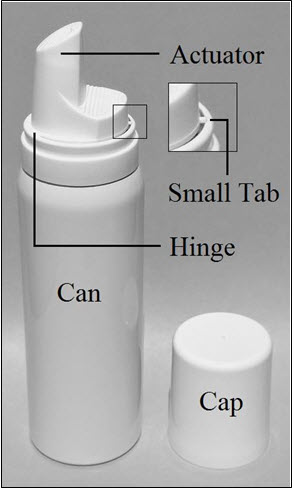
Step 1: Before applying Halobetasol Propionate Topical Foam for the first time, remove cap and break the small tab at the base of the actuator by gently pushing the actuator away from the tab as shown. Do not break the hinge on the actuator. 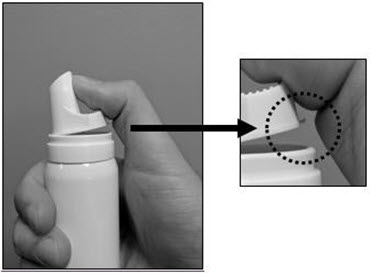
Step 2: Shake the can well before use. 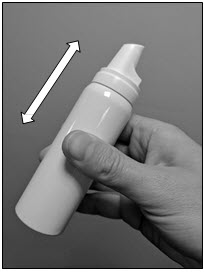
Step 3: Turn the can completely upside down. 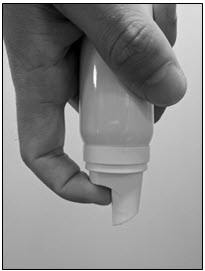
Step 4: Press down on the actuator to dispense a small amount of the foam into the palm of your hand. 
Step 5: Apply a thin layer of Halobetasol Propionate Topical Foam to the affected skin area. Gently rub Halobetasol Propionate Topical Foam into the affected skin until the foam disappears.
Repeat Steps 4 and 5 to all the affected areas as prescribed by your healthcare provider.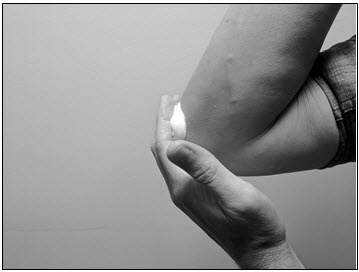
Step 6: After applying Halobetasol Propionate Topical Foam, put the cap back on the can. Step 7: Wash your hands after applying Halobetasol Propionate Topical Foam unless you are using the medicine to treat your hands. This Instructions for Use has been approved by the U.S. Food and Drug Administration.
Distributed by: Mayne Pharma
Greenville, NC 27834
U.S. Patent Pending
Issued: 01/2019 -
PRINCIPAL DISPLAY PANEL - 50 g Canister Label
NDC: 51862-606-50
Halobetasol
Propionate
Topical Foam, 0.05%For topical use only.
Not for ophthalmic, oral, or intravaginal use.
Keep Out of Reach of Children.
Rx ONLY
Net Wt. 50 g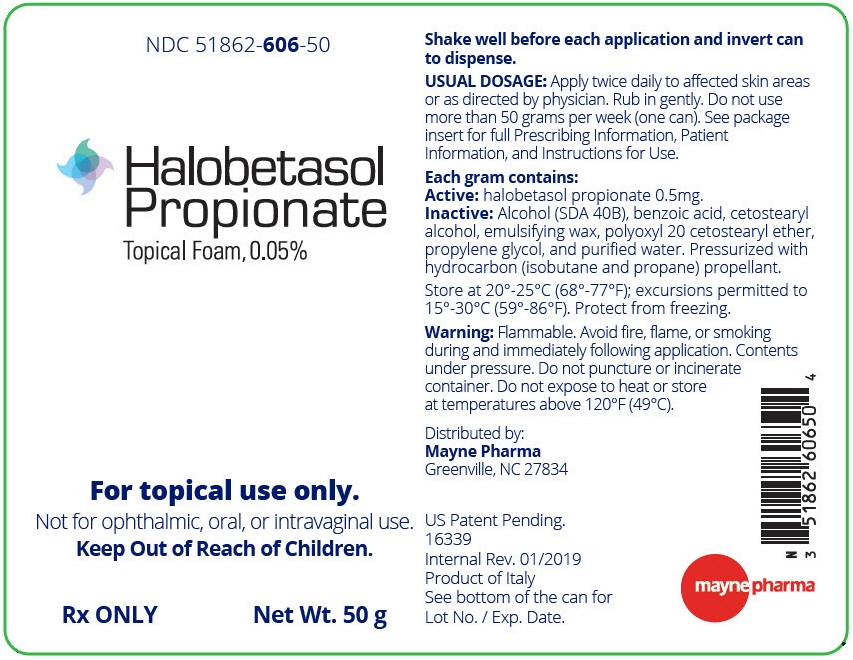
-
INGREDIENTS AND APPEARANCE
HALOBETASOL PROPIONATE
halobetasol propionate aerosol, foamProduct Information Product Type HUMAN PRESCRIPTION DRUG Item Code (Source) NDC: 51862-606 Route of Administration TOPICAL Active Ingredient/Active Moiety Ingredient Name Basis of Strength Strength Halobetasol propionate (UNII: 91A0K1TY3Z) (Halobetasol - UNII:9P6159HM7T) Halobetasol propionate 0.5 mg in 1 g Inactive Ingredients Ingredient Name Strength ALCOHOL (UNII: 3K9958V90M) Propylene Glycol (UNII: 6DC9Q167V3) POLAWAX POLYSORBATE (UNII: Q504PL8E0V) Polyoxyl 20 Cetostearyl Ether (UNII: YRC528SWUY) Cetostearyl Alcohol (UNII: 2DMT128M1S) WATER (UNII: 059QF0KO0R) Benzoic Acid (UNII: 8SKN0B0MIM) Packaging # Item Code Package Description Marketing Start Date Marketing End Date 1 NDC: 51862-606-50 1 in 1 CARTON 02/04/2019 01/31/2022 1 50 g in 1 CANISTER; Type 0: Not a Combination Product 2 NDC: 51862-606-33 1 in 1 CARTON 02/04/2019 02/28/2021 2 17 g in 1 CANISTER; Type 0: Not a Combination Product 3 NDC: 51862-606-02 2 in 1 CARTON 02/04/2019 05/31/2021 3 50 g in 1 CANISTER; Type 0: Not a Combination Product Marketing Information Marketing Category Application Number or Monograph Citation Marketing Start Date Marketing End Date NDA NDA210566 02/04/2019 01/31/2022 Labeler - Mayne Pharma (867220261) Establishment Name Address ID/FEI Business Operations Pharmasol Corporation 065144289 ANALYSIS(51862-606) , MANUFACTURE(51862-606) , PACK(51862-606) , LABEL(51862-606)
© 2025 FDA.report
This site is not affiliated with or endorsed by the FDA.